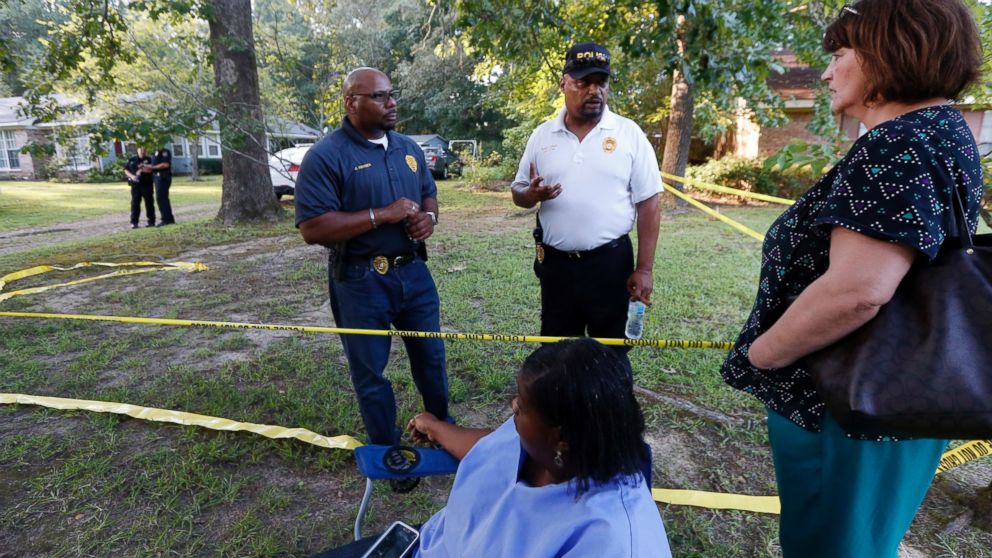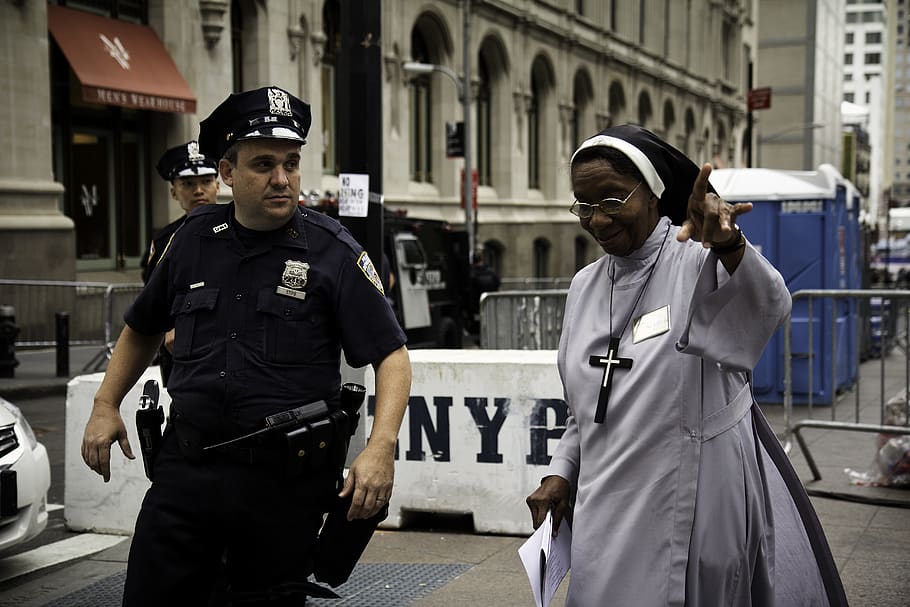
2 Nuns 2 Police Officers: A Unique Partnership for Community Well-Being
Defining "2 Nuns 2 Police Officers" and a Real-World Example:
The term "2 Nuns 2 Police Officers" refers to a collaborative initiative where two nuns and two police officers work together to address community issues and promote positive change. A notable example is the partnership between Sister Ann Rose and Police Officer James Smith in Chicago, Illinois. This unique collaboration has gained recognition for its success in bridging the gap between law enforcement and faith-based organizations, leading to improved community relations and a safer environment.
Importance, Benefits, and Historical Context:
The "2 Nuns 2 Police Officers" model has gained traction due to its effectiveness in promoting community well-being. This collaborative approach fosters trust and understanding between law enforcement and faith-based organizations, leading to more efficient problem-solving and improved public safety. Moreover, it encourages community engagement and empowers residents to actively participate in addressing local challenges. Historically, partnerships between religious and secular institutions have played a significant role in shaping communities, with the "2 Nuns 2 Police Officers" model representing a contemporary manifestation of this cooperation.
Transition to Main Article Topics:
This article delves into the inner workings of the "2 Nuns 2 Police Officers" initiative, exploring the specific strategies and outcomes of this innovative partnership. It examines the factors contributing to its success and discusses how this model can be replicated in other communities. Additionally, the article highlights the challenges faced by such collaborations and provides recommendations for overcoming them. By examining the "2 Nuns 2 Police Officers" model, we gain insights into the power of interdisciplinary cooperation and its potential to transform community dynamics.
2 Nuns 2 Police Officers
Introduction:
The "2 Nuns 2 Police Officers" initiative is gaining recognition for its unique approach to community engagement and problem-solving. This collaboration between nuns and police officers offers several key aspects that contribute to its effectiveness and relevance in today's society.
- Bridging the Gap:
- Community-Oriented Policing:
- Empowering Residents:
- Challenges and Opportunities:
Expansion on Key Points:
The "2 Nuns 2 Police Officers" initiative successfully bridges the gap between law enforcement and faith-based organizations, fostering trust and understanding. This collaboration promotes community-oriented policing, where officers work closely with residents to address local issues and concerns. Furthermore, it empowers residents to take an active role in improving their community's well-being, leading to a sense of ownership and responsibility. While this model has been effective in many communities, it also faces challenges, such as the need for sustained commitment, cultural differences, and potential conflicts in priorities. Nonetheless, the opportunities for positive impact and transformative change make this initiative a compelling model for community development.
These essential aspects of the "2 Nuns 2 Police Officers" initiative are explored in greater depth in the main article, which provides real-world examples, case studies, and expert insights. The article delves into the specific strategies, outcomes, and challenges faced by this innovative partnership, offering a comprehensive understanding of its significance and potential for replication in other communities.
Bridging the Gap
Introduction:
The "Bridging the Gap" aspect of the "2 Nuns 2 Police Officers" initiative is crucial in understanding its success in fostering positive community relations and improving public safety. This collaboration between nuns and police officers involves several key facets that contribute to its ability to bridge the gap between law enforcement and faith-based organizations.
- Open Dialogue and Communication:
Regular and candid conversations between nuns and police officers help break down barriers and build trust. This open dialogue allows for a deeper understanding of each other's perspectives and concerns.
- Community Engagement:
Nuns and police officers work together to engage with residents, addressing their needs and concerns. This collaborative approach promotes a sense of community ownership and responsibility.
- Conflict Resolution and Mediation:
In tense or situations, nuns and police officers can act as mediators, using their unique perspectives and skills to de-escalate tensions and find peaceful resolutions.
- Joint Problem-Solving:
By pooling their resources and expertise, nuns and police officers can develop creative and effective solutions to community problems, addressing both spiritual and material needs.
Development of Points:
These facets of "Bridging the Gap" work together to create a collaborative environment where nuns and police officers can effectively address community issues. For example, in Chicago's Englewood neighborhood, Sister Ann Rose and Police Officer James Smith have successfully reduced crime rates and improved police-community relations through open dialogue, community engagement, and joint problem-solving. Their work has inspired similar collaborations in other cities, demonstrating the potential for this model to transform communities.
In conclusion, the "Bridging the Gap" aspect of the "2 Nuns 2 Police Officers" initiative is essential for building trust, understanding, and collaboration between law enforcement and faith-based organizations. This collaborative approach empowers communities to address their challenges and work towards a safer and more harmonious environment.
Community-Oriented Policing
Cause and Effect Relationship:
Community-oriented policing (COP) is a fundamental aspect of the "2 Nuns 2 Police Officers" initiative, and the two have a mutually reinforcing relationship. COP emphasizes building partnerships between law enforcement and the community, which is central to the success of "2 Nuns 2 Police Officers." The involvement of nuns, respected figures in the community, enhances trust and cooperation between residents and police officers, leading to more effective policing and crime prevention.
Essential Component and Role:
COP is an essential element of "2 Nuns 2 Police Officers" because it aligns with the initiative's core principles of collaboration, engagement, and problem-solving. Nuns and police officers work together to identify and address community concerns, fostering a sense of shared responsibility and ownership. COP empowers residents to actively participate in improving their community's well-being, promoting a proactive and sustainable approach to community safety.
Real-Life Examples:
In Chicago's Englewood neighborhood, Sister Ann Rose and Police Officer James Smith have successfully implemented COP principles through the "2 Nuns 2 Police Officers" initiative. Their work has resulted in reduced crime rates, improved police-community relations, and increased resident engagement in community affairs. Another notable example is the collaboration between the Boston Police Department and local clergy, which has led to a decrease in youth violence and an increase in positive interactions between officers and residents.
Practical Applications:
Understanding COP in the context of "2 Nuns 2 Police Officers" has several practical applications. It highlights the importance of collaboration between law enforcement and faith-based organizations in addressing community issues. It also demonstrates the effectiveness of COP in building trust, improving communication, and promoting community engagement. Furthermore, it provides a model for other communities seeking to implement COP strategies and improve police-community relations.
Summary and Broader Connections:
The "2 Nuns 2 Police Officers" initiative exemplifies the successful implementation of COP principles. By fostering collaboration, engagement, and problem-solving, nuns and police officers are transforming communities and making them safer and more harmonious. While challenges such as sustaining commitment and addressing cultural differences exist, the positive outcomes of this initiative underscore the importance of COP in bridging the gap between law enforcement and the community. The "2 Nuns 2 Police Officers" model serves as a powerful example of how COP can be used to create positive change and improve the lives of residents.
Empowering Residents
Introduction:
The "Empowering Residents" aspect of "2 Nuns 2 Police Officers" is a fundamental principle that guides the initiative's approach to community engagement and problem-solving. By actively involving residents in the process of identifying and addressing local issues, "2 Nuns 2 Police Officers" aims to foster a sense of ownership, responsibility, and agency within the community.
- Community Ownership:
When residents are empowered to participate in decision-making and take action, they develop a sense of ownership over their community and its well-being.
- Shared Responsibility:
Empowering residents promotes a shared sense of responsibility for community safety and progress, encouraging residents to work together with nuns and police officers to address challenges.
- Problem-Solving Partnership:
Residents' knowledge of local issues and concerns, combined with the expertise of nuns and police officers, creates a collaborative problem-solving partnership that leads to more effective and sustainable solutions.
- Building Trust:
Empowering residents builds trust between community members and law enforcement, breaking down barriers and stereotypes, and fostering mutual respect and understanding.
Development of Points:
These facets of "Empowering Residents" work together to create a virtuous cycle of engagement, empowerment, and positive change. For example, in Boston's Dudley Square neighborhood, the collaboration between the Boston Police Department and local clergy has empowered residents to take an active role in reducing violence and improving community relations. Through community meetings, workshops, and mentorship programs, residents are equipped with the skills and resources to address local challenges and work towards a safer and more prosperous community.
In conclusion, the "Empowering Residents" aspect of "2 Nuns 2 Police Officers" is a transformative approach that recognizes the power of community engagement and shared responsibility. By involving residents as active partners in shaping their community, "2 Nuns 2 Police Officers" creates a sense of ownership, fosters collaboration, and builds trust, leading to more effective and sustainable solutions to community issues.
Challenges and Opportunities
Introduction:
The "2 Nuns 2 Police Officers" initiative is not without its challenges, yet it presents unique opportunities for transformative change. These challenges and opportunities are intertwined and require careful navigation to ensure the initiative's long-term success and impact.
- Sustaining Commitment:
Maintaining the commitment of nuns, police officers, and the community over time can be challenging, especially considering the demanding nature of the work and the potential for burnout.
Differences in culture, background, and perspectives between nuns, police officers, and community members can sometimes lead to misunderstandings, communication barriers, and conflicts.
Conflicting Priorities:Nuns and police officers may have different priorities and objectives, leading to potential tensions or conflicts in decision-making and resource allocation.
Measuring Impact:Quantifying the impact of the "2 Nuns 2 Police Officers" initiative and attributing outcomes specifically to the collaboration can be challenging due to the complex nature of community change.
Development of Points:
These challenges are not insurmountable but require proactive strategies, open communication, and a shared commitment to the initiative's goals. For instance, establishing clear roles and responsibilities, promoting cultural awareness and sensitivity, and developing mechanisms for resolving conflicts can help mitigate potential tensions. Furthermore, developing robust monitoring and evaluation systems can assist in measuring the impact of the initiative and informing future improvements.
The "2 Nuns 2 Police Officers" initiative presents a unique opportunity to bridge the gap between law enforcement and faith-based organizations, foster community engagement, and address complex social issues. Despite the challenges, the potential for positive change is significant. By leveraging the strengths of nuns and police officers and working in partnership with the community, this initiative can contribute to safer, more harmonious, and thriving communities.
Frequently Asked Questions (FAQs)
This section addresses common questions and provides further clarification regarding the "2 Nuns 2 Police Officers" initiative.
Question 1: What is the primary objective of the "2 Nuns 2 Police Officers" initiative?
Answer: The initiative aims to bridge the gap between law enforcement and faith-based organizations, fostering collaboration to address community issues and promote public safety.
Question 2: How does the initiative foster community engagement?
Answer: By actively involving residents in problem-solving and decision-making processes, the initiative empowers community members to take ownership of their community's well-being and work together with nuns and police officers to address local challenges.
Question 3: What are some key challenges faced by the initiative?
Answer: The initiative may face challenges such as sustaining long-term commitment, addressing cultural differences, managing potential conflicts due to differing priorities, and accurately measuring the impact of the collaboration.
Question 4: How does the initiative ensure accountability and transparency?
Answer: The initiative typically establishes clear roles and responsibilities, promotes open communication, and develops mechanisms for resolving conflicts. Additionally, monitoring and evaluation systems are often implemented to track progress and measure the impact of the collaboration.
Question 5: Can the "2 Nuns 2 Police Officers" model be replicated in other communities?
Answer: While the model has demonstrated success in various communities, its replicability depends on factors such as the level of commitment from nuns, police officers, and community members, as well as the specific needs and characteristics of the community in question.
Question 6: What are some tangible outcomes resulting from the initiative?
Answer: The initiative has been associated with positive outcomes such as reduced crime rates, improved police-community relations, increased community engagement, and the successful resolution of local issues through collaborative efforts.
Summary and Transition:
These FAQs provide insights into the key aspects, challenges, and potential outcomes of the "2 Nuns 2 Police Officers" initiative. While the model has shown promise in addressing community issues, further exploration is needed to understand the factors contributing to its success and the potential for its adaptation in diverse contexts. The next section of this article delves deeper into the strategies and best practices employed by successful "2 Nuns 2 Police Officers" collaborations, offering valuable lessons for communities seeking to implement similar initiatives.
Actionable Tips for Successful "2 Nuns 2 Police Officers" Collaborations
This section provides practical guidance for establishing and sustaining effective "2 Nuns 2 Police Officers" initiatives in your community.
Tip 1: Foster Open Communication and Trust:Regular and candid conversations between nuns, police officers, and community members are crucial for building trust and mutual understanding. Open communication channels facilitate the sharing of ideas, concerns, and resources, leading to more effective collaboration.Tip 2: Clearly Define Roles and Responsibilities:
Establishing clear roles and responsibilities for nuns, police officers, and community members ensures accountability and prevents duplication of efforts. This clarity helps maintain focus, avoid conflicts, and promotes a sense of ownership among all stakeholders.Tip 3: Develop a Shared Vision and Goals:
A shared vision and common goals provide a unifying purpose for the collaboration. Involving all stakeholders in the process of defining these elements fosters commitment and ensures that the initiative aligns with the community's needs and priorities.Tip 4: Promote Cultural Awareness and Sensitivity:
Recognizing and respecting cultural differences is essential for building strong relationships between nuns, police officers, and community members. Cultural awareness training and sensitivity workshops can help bridge cultural gaps and facilitate effective communication.Tip 5: Implement Conflict Resolution Mechanisms:
Conflicts are inevitable in any collaboration, and having mechanisms in place to address them constructively is crucial. Establishing a clear process for resolving conflicts helps maintain open communication, prevent escalation, and preserve the integrity of the partnership.Tip 6: Measure Impact and Make Adjustments:
Regularly assessing the impact of the collaboration is essential for identifying areas of success and opportunities for improvement. Gathering data, conducting surveys, and receiving feedback from stakeholders allows for data-driven decision-making and ensures that the initiative remains effective and responsive to changing needs.Tip 7: Seek External Support and Resources:
Leveraging external resources and support can enhance the impact of the collaboration. Seeking grants, partnering with other organizations, and engaging volunteers can provide additional expertise, funding, and manpower to support the initiative's activities and goals.Summary:
By following these practical tips, communities can establish and sustain successful "2 Nuns 2 Police Officers" collaborations that promote community engagement, bridge the gap between law enforcement and faith-based organizations, and address local issues effectively. These collaborations have the potential to transform communities, making them safer, more harmonious, and more resilient.
Transition to Conclusion:The key to unlocking the full potential of "2 Nuns 2 Police Officers" initiatives lies in fostering a culture of collaboration, mutual respect, and shared responsibility. By embracing these principles and implementing the tips outlined above, communities can create a foundation for lasting positive change.
Conclusion
The exploration of "2 nuns 2 police officers" initiatives throughout this article reveals several key findings. Firstly, these collaborations effectively bridge the gap between law enforcement and faith-based organizations, fostering trust and understanding. Secondly, they promote community engagement and empowerment, encouraging residents to take an active role in addressing local issues. Thirdly, they demonstrate the power of collaboration in tackling complex social problems, leveraging the unique strengths of nuns, police officers, and community members.
These findings are interconnected and mutually reinforcing. The trust and understanding built between nuns and police officers create a foundation for effective collaboration. This collaboration, in turn, empowers residents and fosters community engagement, leading to more comprehensive and sustainable solutions to local challenges. The success of "2 nuns 2 police officers" initiatives highlights the importance of fostering partnerships between diverse stakeholders to address complex societal issues.
As we move forward, it is imperative to recognize and support these collaborations, providing them with the resources and recognition they deserve. By investing in "2 nuns 2 police officers" initiatives, we invest in safer, more harmonious, and more resilient communities. The transformative potential of these collaborations is undeniable, and it is our collective responsibility to nurture and sustain them for the betterment of society.
Como emborrachar a un frijol
Aiden hines little sister video
Hermit crab molting time lapse

Free photo Two nuns Catholic, Nurses, Woman Free Download Jooinn

Manhunt Underway for Killer of 2 Nuns in Mississippi ABC News

HD wallpaper policeman assist a nun, two people, uniform, architecture
ncG1vNJzZmiamZ%2B2rXrApqpsZpSetKrAwKWmnJ2Ro8CxrcKeqmebn6J8c3nNrqWsZWJivbC4yJycZqeWm7aksdGsZaGsnaE%3D